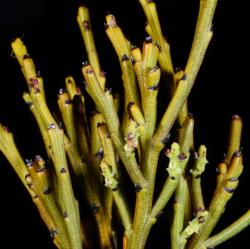- Taxon
- Gallery
Classification
Class
Family
Genus
Nomenclature
Scientific Name:
Exocarpos bidwillii Hook.f., Bot. Antarct. Voy. II. (Fl. Nov.-Zel.) Part I, 223, t. 52 (1853) – as Exocarpus bidwillii
Description
Rigid, ± procumbent, much-branched shrub up to ± 6 dm. long. Branches and branchlets very stiff, ascending at a narrow angle, ± terete, grooved; branchlets yellow-brown, ± 2 mm. diam. Lvs alt., reduced to persistent triangular black scales hardly up to 0·5 mm. long. Infl. a 4–10-fld rigid, axillary, ± pubescent spike up to 5 mm. long. Fls seated in alt. excavations, subtended by minute triangular bracts. Tepals black, (4)–5–(6), triangular, persistent. Staminal filaments very short. Fr. nutlike, ellipsoid, dark, ± 5 mm. long, on us. much enlarged, often red and succulent pedicels.
[From: Allan (1961) Flora of New Zealand. Volume 1.]
Biostatus
Indigenous (Endemic)
Phenology
Flowering: Jan.–Feb.; Fruiting: Jan.–Apr.
Bibliography
de Lange, P.J.; Rolfe, J.R.; Champion, P.D.; Courtney, S.P.; Heenan, P.B.; Barkla, J.W.; Cameron, E.K.; Norton, D.A.; Hitchmough, R.A. 2013: Conservation status of New Zealand indigenous vascular plants, 2012. New Zealand Threat Classification Series 3. Department of Conservation, Wellington. [Not Threatened]
Hooker, J.D. 1852–1853 ("1853"): The Botany of the Antarctic Voyage of H.M. Discovery Ships Erebus and Terror in the Years 1839–1843, under the command of Captain Sir James Clark Ross. II. Flora Novae-Zelandiae. Part I. Flowering plants. Lovell Reeve, London.




